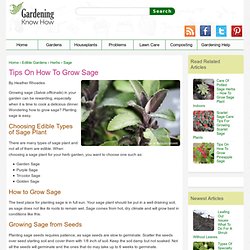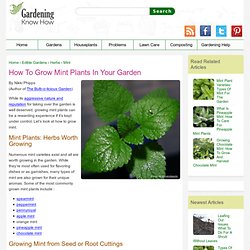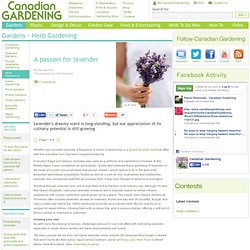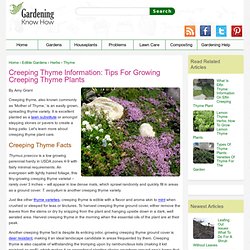

Easy-to-Grow Herbs. Learn How To Grow Sage In Gardens. By Heather Rhoades Growing sage (Salvia officinalis) in your garden can be rewarding, especially when it is time to cook a delicious dinner.

Wondering how to grow sage? Planting sage is easy. Choosing Edible Types of Sage Plant There are many types of sage plant and not all of them are edible. Garden SagePurple SageTri-color SageGolden Sage How to Grow Sage The best place for planting sage is in full sun. Growing Sage from Seeds Planting sage seeds requires patience, as sage seeds are slow to germinate. Growing Sage from Cuttings More commonly, sage is grown from cuttings. Now that you know how to grow sage, there is no excuse not to add this delicious herb to your garden. This article was last updated on Did you find this helpful? Additional Help & Information Didn't find the answer to your question? Do you know anything about gardening? Read more articles about Sage. Search for more information Use the search box below to find more gardening information on Gardening Know How:
Tips On Growing Mint In The Garden. By Nikki Phipps (Author of The Bulb-o-licious Garden) While its aggressive nature and reputation for taking over the garden is well deserved, growing mint plants can be a rewarding experience if it’s kept under control.

Let’s look at how to grow mint. Mint Plants: Herbs Worth Growing Numerous mint varieties exist and all are worth growing in the garden. While they’re most often used for flavoring dishes or as garnishes, many types of mint are also grown for their unique aromas. A passion for lavender. Lavender's dreamy scent is long-standing, but our appreciation of its culinary potential is still growing Whether you consider lavender a fragrance, a colour, a seasoning or a perennial plant, our love affair with this evocative herb has been long and enduring.

In ancient Egypt and Greece, lavender was used as a perfume and ingredient in incense. In the Middle Ages, it was considered an aphrodisiac. (It was also believed that a sprinkling of lavender on the head of a loved one would keep that person chaste—which seems to fly in the face of its purported aphrodisiac properties!) Touted as well as a cure for lice, toothaches and headaches, lavender was considered quite the all-purpose herb.
Reading through lavender lore, one is less likely to find mention of its culinary use, although it's said that Queen Elizabeth I savoured lavender conserve and a lavender tisane (a herbal infusion sweetened with honey) made from plants grown at her palace. Top photo: 'Grosso' Lavendin Hybrid. How to grow lavender. Hardy noninvasive perennials, lavenders suit both informal and formal gardens.

Mature lavenders form dense mounds of foliage, ranging from grey to green and from 30 to 60 centimetres tall – beautiful even when they're not blooming. And lavender's not just blue – you can choose a plant that flowers in white, pink or pale purple through to inky, intense blue or violet. In a flowerbed, the blooming plants provide a cloud of hazy colour that softens the contours of leggy companions such as roses. Planted in a row, compact varieties form a low hedge to edge a bed or path, or trace the outline of a traditional knot garden filled with other herbs. Perhaps the best part? How to grow it Given a sunny, well-drained site, lavenders will thrive in dry, poor soil and even self-seed. Compact varieties grow happily in containers, but require a coarse potting mix that doesn't stay soggy, and you will need to water, sparingly, in the summer. You can also use the dried flowers in the kitchen.
Creeping Thyme Plant Care – How To Plant Creeping Thyme Ground Cover. By Amy Grant Creeping thyme, also known commonly as ‘Mother of Thyme,’ is an easily grown, spreading thyme variety.

It is excellent planted as a lawn substitute or amongst stepping stones or pavers to create a living patio. Let’s learn more about creeping thyme plant care. Creeping Thyme Facts Thymus praecox is a low growing perennial hardy in USDA zones 4-9 with fairly minimal requirements. Just like other thyme varieties, creeping thyme is edible with a flavor and aroma akin to mint when crushed or steeped for teas or tinctures. Another creeping thyme fact is despite its enticing odor, growing creeping thyme ground cover is deer resistant, making it an ideal landscape candidate in areas frequented by them. Flowering creeping thyme is very attractive to bees and is a nice addition to a garden focused on honeybees and, in fact, the pollen from the blooming thyme will flavor the resulting honey.